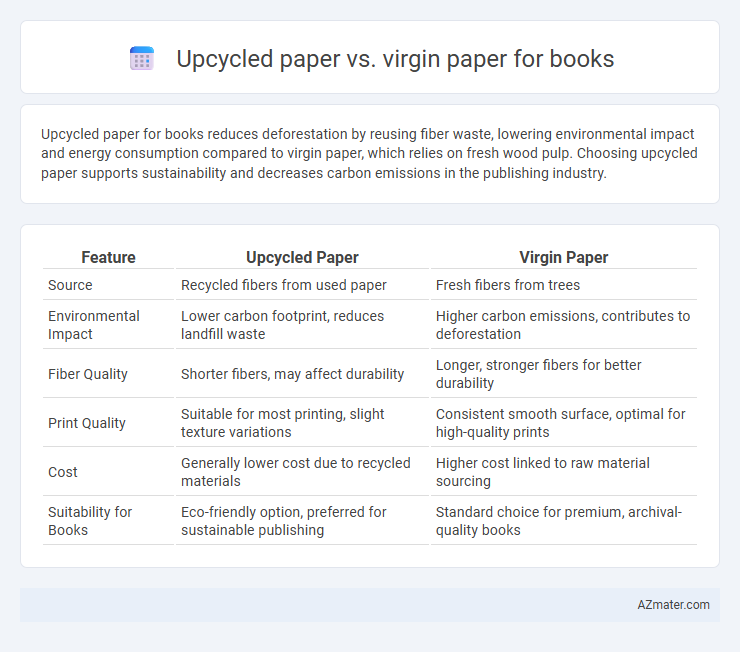Upcycled paper for books reduces deforestation by reusing fiber waste, lowering environmental impact and energy consumption compared to virgin paper, which relies on fresh wood pulp. Choosing upcycled paper supports sustainability and decreases carbon emissions in the publishing industry.
Table of Comparison
| Feature | Upcycled Paper | Virgin Paper |
|---|---|---|
| Source | Recycled fibers from used paper | Fresh fibers from trees |
| Environmental Impact | Lower carbon footprint, reduces landfill waste | Higher carbon emissions, contributes to deforestation |
| Fiber Quality | Shorter fibers, may affect durability | Longer, stronger fibers for better durability |
| Print Quality | Suitable for most printing, slight texture variations | Consistent smooth surface, optimal for high-quality prints |
| Cost | Generally lower cost due to recycled materials | Higher cost linked to raw material sourcing |
| Suitability for Books | Eco-friendly option, preferred for sustainable publishing | Standard choice for premium, archival-quality books |
Introduction to Upcycled and Virgin Paper
Upcycled paper is produced by reprocessing waste paper materials to create a new, eco-friendly product with reduced environmental impact, whereas virgin paper is made directly from freshly harvested wood fibers, ensuring higher strength and brightness. Upcycled paper leverages recycled content to minimize deforestation and energy consumption, while virgin paper offers superior durability and print quality, often preferred for premium books. The choice between upcycled and virgin paper influences sustainability goals and the overall quality of the finished book product.
Environmental Impact: Upcycled vs Virgin Paper
Upcycled paper significantly reduces environmental impact by minimizing deforestation, conserving water, and lowering energy consumption compared to virgin paper, which relies on fresh wood pulp and intensive resource use. The production of virgin paper generates higher greenhouse gas emissions and contributes to habitat loss, while upcycled paper leverages recycled materials, reducing landfill waste and pollution. Choosing upcycled paper for books supports sustainable forestry practices and promotes circular economy principles essential for environmental preservation.
Resource Consumption and Sustainability
Upcycled paper for books significantly reduces resource consumption by minimizing the need for virgin wood fibers, preserving forests, and lowering water and energy use during production. Virgin paper, derived directly from newly harvested trees, has a higher environmental impact due to intensive deforestation, water depletion, and chemical processing. Choosing upcycled paper enhances sustainability by promoting waste reduction and supporting circular economy practices in the publishing industry.
Quality and Durability Comparison
Upcycled paper for books offers a sustainable alternative but generally exhibits lower durability and a rougher texture compared to virgin paper, which is manufactured from fresh wood fibers designed for strength and longevity. Virgin paper provides superior print clarity and resistance to yellowing, making it ideal for high-quality publications intended to last over time. While upcycled paper suits eco-friendly projects, virgin paper remains the preferred choice for premium book production due to its consistent quality and durability.
Cost Analysis: Upcycled vs Virgin Paper
Upcycled paper typically reduces costs by utilizing recycled materials, lowering raw material expenses and decreasing energy consumption compared to virgin paper production. Virgin paper, derived from fresh pulp, demands higher costs due to extensive logging, chemical treatments, and energy-intensive processes. Considering long-term sustainability and market demand, upcycled paper provides a cost-effective alternative for book manufacturing without significant compromises in quality.
Aesthetics and Print Performance
Upcycled paper for books offers a unique, rustic aesthetic with visible fibers and a natural texture that enhances vintage or artisanal designs. Virgin paper provides superior print performance, delivering crisp text and vibrant images due to its smooth, uniform surface and high-quality pulp. While virgin paper ensures consistent color reproduction and sharp detail, upcycled paper's charm lies in its eco-friendly appeal and distinct tactile experience.
Supply Chain and Sourcing Considerations
Upcycled paper reduces reliance on virgin wood pulp, easing pressure on forests and minimizing environmental impact within the book supply chain. Sourcing upcycled paper often involves securing post-consumer waste streams, which can introduce variability in fiber quality and availability compared to the consistent raw materials needed for virgin paper production. Supply chain logistics for upcycled paper may require closer coordination with recycling facilities and quality control processes to ensure durability and print clarity in finished books.
Market Demand and Industry Trends
Upcycled paper for books is gaining traction due to increasing consumer demand for sustainable and eco-friendly products, with market trends showing a significant shift towards reducing carbon footprints and deforestation. Virgin paper, made from fresh wood pulp, still dominates the market due to its superior quality and printing performance, but faces growing pressure from environmental regulations and shifting publisher preferences. Industry forecasts predict a steady growth in the upcycled paper segment, driven by advances in recycling technology and heightened awareness of circular economy principles.
Eco-Certifications and Standards
Upcycled paper for books often carries eco-certifications such as FSC Recycled and Green Seal, ensuring sustainable sourcing and reduced environmental impact by reusing post-consumer waste. Virgin paper, typically certified by FSC or PEFC, guarantees that fibers come from responsibly managed forests but involves higher resource consumption and carbon emissions. Choosing upcycled paper with recognized eco-standards supports circular economy principles and lowers the book's overall ecological footprint.
Conclusion: Choosing the Right Paper for Books
Upcycled paper offers a sustainable and eco-friendly option for book production by reducing waste and conserving natural resources, while virgin paper provides superior brightness and durability for high-quality print. The choice depends on the desired environmental impact, print quality, and target audience preferences. Balancing sustainability with performance ensures an informed decision tailored to the specific needs of each book project.

Infographic: Upcycled paper vs Virgin paper for Book
 azmater.com
azmater.com